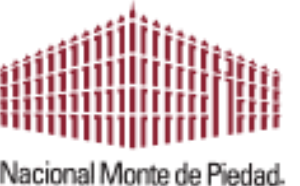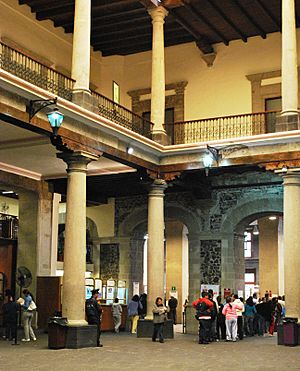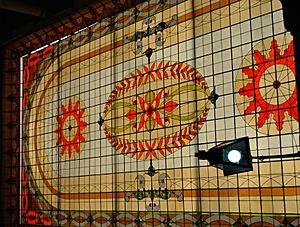Nacional Monte de Piedad facts for kids
 |
|
| Private | |
| Industry | Pawnshop |
| Founded | 1774 |
| Headquarters | Mexico City |
The Nacional Monte de Piedad is a special kind of non-profit organization. It's like a pawnshop that helps people by offering loans. Its main office is in Mexico City, close to the big central square called the Zócalo.
This organization was started between 1774 and 1777 by Don Pedro Romero de Terreros, who was also known as the Count of Regla. He wanted to help people who were struggling financially. So, he created a place where they could get loans with no interest or very low interest. In 1927, the Mexican government officially recognized it as a national charity. Since the early 2000s, it has grown a lot. Today, it has over 200 branches all across Mexico.
Contents
The Main Office Building
The main office building is located on the northwest side of the Zocalo square. It's at the corner of Monte de Piedad and 5 de Mayo Streets. This building has been changed a lot over the years. But it was once part of a huge property owned by Hernán Cortés (who lived from 1485 to 1547).
Even before Cortés, this area was home to the "Old Houses" of Moctezuma II's father, Axayacatl (who lived from about 1453 to 1483). When Cortés arrived, Moctezuma lived in the "New Houses" across the main plaza, where the National Palace stands today. The original property was so big that one writer, Francisco Cervantes de Salazar, said it was like a whole city! Others compared it to the Cretan labyrinth.
The first building had two floors and smaller buildings that Cortés rented out. The main part used to be a royal court and home to some early leaders of New Spain. In 1615, the property was divided and sold.
Building Features and History
The outside of the current building, made of tezontle stone, dates back to 1775. Above the main door, you can see the coat of arms of the Count of Regla. Inside the main entrance, there's also Mexico's coat of arms and a statue of Don Pedro Romero de Terreros. The inside of the building has been completely changed, except for a few small details. A third floor was added in 1948.
What used to be Cortés's accounting room became a chapel until 1926. Since then, it has been a museum. This museum displays paintings from 1775, old decorations from the 1700s and 1800s, old stamps, paper money, and the building's original statues.
In 1984, the building had a big renovation. The outside walls were cleaned, and the wood and iron parts were fixed and protected from pollution. Floors, patios, and columns were cleaned and shined. Special protections were added to the windows where items are appraised, and the art room was made larger.
On April 17, 2004, a fire started in the building due to an electrical problem. It began in the rooms where cashiers and appraisers worked. Ten people were there for a remodeling project, but luckily, no pawned items were damaged.
The Institution's Story
How it Started
The idea of "Monte di Pietà" started in Perugia, Italy, in 1450. It was created by the Franciscan Order. The goal was to help people financially by giving them loans without charging interest. Instead of interest, people were encouraged to give donations to the Church. This idea spread from Italy to other parts of Europe. The first Monte de Piedad in Spain was in Madrid. From there, the idea came to New Spain (Mexico) thanks to Pedro Romero de Terreros.
Terreros (1710–1781) was born in Spain and came to Mexico in 1730. He started many businesses, including the Real del Monte silver mine. He founded the Sacro y Real Monte Pío de Animas between 1774 and 1777. The Spanish king, Charles III, approved his plan. Terreros used part of the College of Saints Peter and Paul for the main office, which is still there today. He started the project by donating 300,000 pesos in gold. Like other Monte de Piedad organizations, his foundation did not charge interest on loans. It also encouraged borrowers to donate to Church institutions, especially the College of Saints Peter and Paul. He also wanted borrowers to go to church and pray to help them spiritually and financially.
The Monte de Piedad started its work in 1775. In 1818, the leader of New Spain, Viceroy Apodaca, ordered the building to be emptied because of problems with the Independence movement. But this didn't happen until 1821. The foundation moved to different locations over the years. In 1836, it bought back its original home from the Duke of Monteleone, who was a descendant of Hernan Cortés.
After Mexico became independent, the new government supported the institution. It also got its current name. In the early 1800s, the Monte de Piedad faced money problems because of poor management and political unrest. However, by the end of the same century, it was doing so well that it even started printing its own money! In 1881, it opened its first branches in other cities like San Luis Potosí, Oaxaca, and Puebla, but these closed soon after. In 1927, the president declared Monte de Piedad a "private charity."
What it Does Today
Since it began, the Monte de Piedad has had two main goals that haven't changed.
The first and most important goal is to give loans to families who need money for emergencies. They try to offer the best possible conditions without focusing on making a profit. Their main way of lending is through microloans, where people pawn (or temporarily give) an object as security. Because the foundation lost money in its early years, the leaders decided in 1782 that they needed to charge a small, fixed interest rate.
Since it's a charity, they will accept items worth as little as 30 pesos. However, the average loan is about 500 pesos. Most of the items pawned are jewelry and watches. But the institution also accepts other things like cars, home appliances, and even sheets and linens. Over time, they have added other financial services, such as banking services (started in 1878) and home equity loans (started in 1997).
The second goal is about what they do with the money they earn. In the last ten years, the institution has given money to more than 1,500 charities. On average, they donate between 400 and 450 million Mexican pesos each year. These charities help many different groups, including children with burns, the Mexican Red Cross, Teleton, and charities that help children with autism, children with cancer, people with AIDS, and victims of domestic violence.
Besides helping charities, the foundation also supports education by offering scholarships. Monte de Piedad has been a main supporter of the "Beca (scholarship) Cholula" fund. At first, they funded one full scholarship each year, and now they sponsor ten students annually. This scholarship helps excellent students from poor communities in Puebla state attend UDLA, which is a private university. So far, they have donated a total of 900,000 pesos to this fund.
How it Operates and Grows
The institution has become very well-known across Mexico, especially since the year 2000. People often lovingly call it "Tia (Aunt) Piedad."
From 1988 to 2000, Monte de Piedad had about 33 to 35 branches in Mexico, with thirteen of them in Mexico City. By January 2008, that number had grown to 152. The plan is to open a branch in every Mexican city. The largest regional offices are in Mexico City, Monterrey, Guadalajara, and Mérida.
In 2008, the foundation expected to give pawn loans to 750,000 families, totaling about 905 million pesos. This was a big increase from 2007. Monte de Piedad stores about 33 million pawned items every year. The institution also expected to reach 22 million loans in 2008. Similar growth has been seen in regional offices like those in Culiacán and Mérida.
People take out loans for many reasons. Monte de Piedad reports that many loans are used to fix up houses, send children to college, or start a business. More people have also been getting loans to cover their credit card overdrafts. However, many loans are for expenses related to going back to school, vacation times (especially Holy Week), and January, after the Christmas holidays.
Loans for back-to-school needs happen in late August and early September. This is the third busiest time for Monte de Piedad. Back-to-school costs usually include school supplies, uniforms, shoes, backpacks, and textbooks. They can also include special supplies for classes like physics and art.
The busiest time for Monte de Piedad is in January, after the holidays. The second busiest time is around the Holy Week vacations. During every major holiday and vacation period, people can be seen lining up at Monte de Piedad offices. They do this to get money for their celebrations, either before or after. A spokesperson for Monte de Piedad, Méndez Tapia, says that in Mexico, people don't rely on credit cards as much. Instead, pawning has been a long-standing part of the financial culture, especially for Mexicans with limited money.
Monte de Piedad charges a four percent interest rate on pawned items. People have seventeen months to get their items back. The recovery rate is very high, at 96%. For comparison, other for-profit pawn shops might charge between twelve and twenty-four percent interest per month. Even with the high recovery rate, every two weeks, items that haven't been claimed by their owners are sold. These items include furniture, antiques, jewelry, cars, clothing, and home appliances. They are sold at public auction at the main office in the Zócalo in Mexico City.
Reputation and Challenges
In 1945, a special department was created to train appraisers. These are the experts who decide how much an item is worth (for jewelry, furniture, art, etc.). To keep its good financial reputation, Monte de Piedad lets outside experts like Standard & Poor's check its financial records. They often give the institution high ratings. The institution has also been certified by AENOR. Legally, the foundation works with law enforcement, like the Attorney General of Chihuahua. They sign agreements to stop people from trying to pawn stolen items.
However, the institution has faced some issues with its employees. In 2007, retired and current employees protested. They said that the institution had told them they were enrolled in the IMSS (a public health insurance program) when they actually were not. The protesters explained that they hadn't realized this for a long time because the company provided private health insurance. Later, a court ruled against Monte de Piedad in a case brought by about 350 employees.
See also
 In Spanish: Nacional Monte de Piedad para niños
In Spanish: Nacional Monte de Piedad para niños






